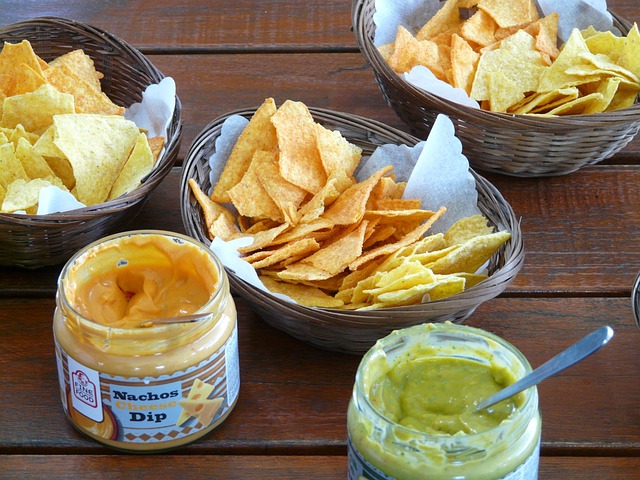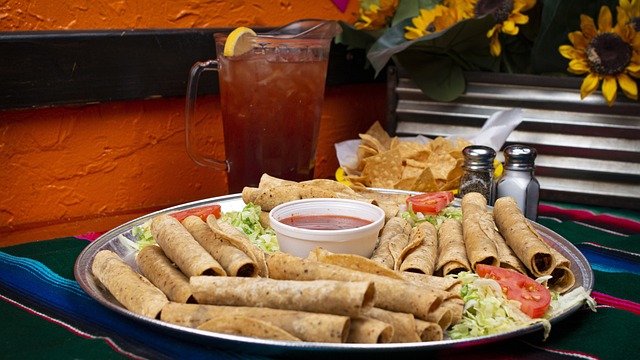Home cooks embark on a culinary adventure to replicate the iconic Mission Restaurant Style Tortilla Chips, a bustling market staple. The process involves selecting high-quality flour tortillas, cutting them into triangles, and mastering oil temperature for even cooking. Personalization is encouraged, allowing individuals to add their own unique seasonings. Mexican markets showcase a diverse food culture, highlighting traditional chip-making methods that contrast with modern mass production. These chips, made with hand-cut edges and optimal frying techniques, offer a nutritious and delicious snack option while preserving essential nutrients.
“Discover the vibrant world of homemade tortilla chips in Mexican markets, where culinary treasures await. From traditional to modern techniques, these chips transcend mere snacking, offering a window into regional kitchens and their unique flavors. Learn how to craft mission restaurant-style tortilla chips at home, exploring health benefits and nutritional considerations. Uncover the art, history, and diverse methods behind these crispy treats, and elevate your culinary experience.”
- The Art of Making Tortilla Chips at Home
- Mexican Markets: A Culinary Treasure Trove
- Traditional vs Modern Tortilla Chip Techniques
- Authentic Flavor Profiles from Regional Kitchens
- Health Benefits and Nutritional Considerations
- Creating a Restaurant-Style Experience at Home
The Art of Making Tortilla Chips at Home

Making tortilla chips at home is an art that many food enthusiasts embrace, seeking to recreate the beloved Mission Restaurant Style Tortilla Chips found in Mexican eateries. The process begins with selecting the perfect flour tortillas, a key ingredient that forms the crispy base of these chips. These tortillas are then cut into uniform triangles, ensuring even cooking and a consistent texture. The secret to achieving that classic golden-brown color lies in a precise combination of oil temperature and soaking time—a delicate dance that requires practice and patience.
Home cooks often experiment with different oils, trying to replicate the signature crunch and flavor profile of their favorite restaurants. Traditional methods involve deep-frying, which results in an airy texture, while some prefer baking for a healthier alternative. Whichever method is chosen, the result is a delicious snack that allows individuals to customize their chips with various seasonings and toppings, offering a personalized twist on a classic Mexican staple.
Mexican Markets: A Culinary Treasure Trove

Mexican markets are a culinary treasure trove, offering a delightful array of flavors and textures that reflect the country’s rich cultural heritage. Among the many treats, one stands out as a true delight for chip lovers: Mission Restaurant Style Tortilla Chips. These chips are not just a simple side dish; they are a testament to the skill and passion of Mexican chefs and artisans. Crafted from freshly ground corn or wheat flour, these tortilla chips are cooked to perfection, resulting in a crisp texture that’s impossible to resist.
The beauty of Mission Restaurant Style Tortilla Chips lies in their versatility. They can be enjoyed on their own, dipped in salsa or guacamole, or as an accompaniment to hearty Mexican dishes like tacos, enchiladas, and quesadillas. The markets become a vibrant, bustling scene where locals and visitors alike gather to sample these homemade chips, immersing themselves in the authentic culinary experience that defines Mexico’s vibrant food culture.
Traditional vs Modern Tortilla Chip Techniques

In the heart of Mexican markets, a timeless tradition comes alive through the art of making tortilla chips, offering a stark contrast to modern industrial production methods. The classic technique involves hand-cut slices from fresh tortillas, carefully fried until crisp, resulting in a textured, authentic chip beloved by many. This method is often associated with the hearty flavors and aromas found in local restaurants, particularly those serving Mission Restaurant Style Tortilla Chips.
In contrast, modern techniques employ machines for mass production, aiming to streamline efficiency while potentially sacrificing the artisanal touch. These chips, though widely available, may lack the depth of flavor and satisfying crunch that comes from traditional preparation methods. The debate between old and new highlights the enduring appeal of authentic Mexican culinary practices and their impact on shaping unique food experiences.
Authentic Flavor Profiles from Regional Kitchens

Mexican markets are a treasure trove for food enthusiasts, offering an array of local delicacies, and at the heart of this culinary experience lie the authentic Mission Restaurant Style Tortilla Chips. These chips are not just a snack but a gateway to diverse regional kitchens across Mexico. Each chip tells a story, reflecting the unique flavor profiles and cooking traditions of different states.
From the crisp, slightly smoky taste of tortilla chips from Oaxaca, known for their artisanal production methods, to the zesty, fresh-limed varieties from Yucatán, every region adds its distinct touch. The traditional preparation techniques, including hand-cut edges and the use of stone grinders, contribute to these chips’ exceptional quality and flavor. Mission Restaurant Style Tortilla Chips truly embody the spirit of Mexican cuisine, bringing a taste of diverse regional kitchens straight to your table.
Health Benefits and Nutritional Considerations

Homemade tortilla chips, often a staple in Mexican markets and cuisine, offer more than just a delicious snack. When made with care, using traditional methods like those employed in authentic Mission Restaurant Style Tortilla Chips, they can be a nutritious addition to your diet. The process of hand-cutting and frying tortillas at optimal temperatures ensures that essential nutrients are retained. These chips are a good source of complex carbohydrates, providing energy without the added sugar or unhealthy fats found in many processed snacks.
Additionally, corn tortillas, a common base for these chips, are packed with important vitamins and minerals, including niacin, folate, and magnesium. They are also a great source of dietary fiber, which supports digestive health and promotes feelings of fullness, making them a satisfying choice for those looking to make healthier snack alternatives.
Creating a Restaurant-Style Experience at Home

Creating a restaurant-style experience at home has become an art for many food enthusiasts, and when it comes to Mexican cuisine, achieving crispy, delicious tortilla chips is within reach. The key lies in understanding the process behind making Mission Restaurant Style Tortilla Chips. It starts with selecting the right flour—a blend of corn and wheat—to ensure a golden-brown color and satisfying crunch. The dough must be carefully mixed, allowing for an optimal balance of ingredients to create that distinctive texture.
After shaping the tortillas into thin, flexible disks, the real magic happens in the frying process. Heat is essential; it transforms the simple dough into crispy chips with a slight charred edge. Many home chefs opt for a deep-frying method, immersing the tortillas in hot oil to achieve that restaurant-worthy crispness and an irresistible aroma that fills any kitchen. This DIY approach allows individuals to experiment with different flavors and toppings, offering a personalized twist on a classic Mexican snack.
Mexican markets offer a culinary treasure trove, showcasing the art of making homemade tortilla chips with authentic regional flavors. From traditional techniques to modern innovations, creating restaurant-style mission chips at home is accessible and rewarding. By exploring various regional kitchens and understanding health considerations, you can transform your kitchen into a bustling culinary laboratory, producing not just chips but an indelible, flavorful experience.
